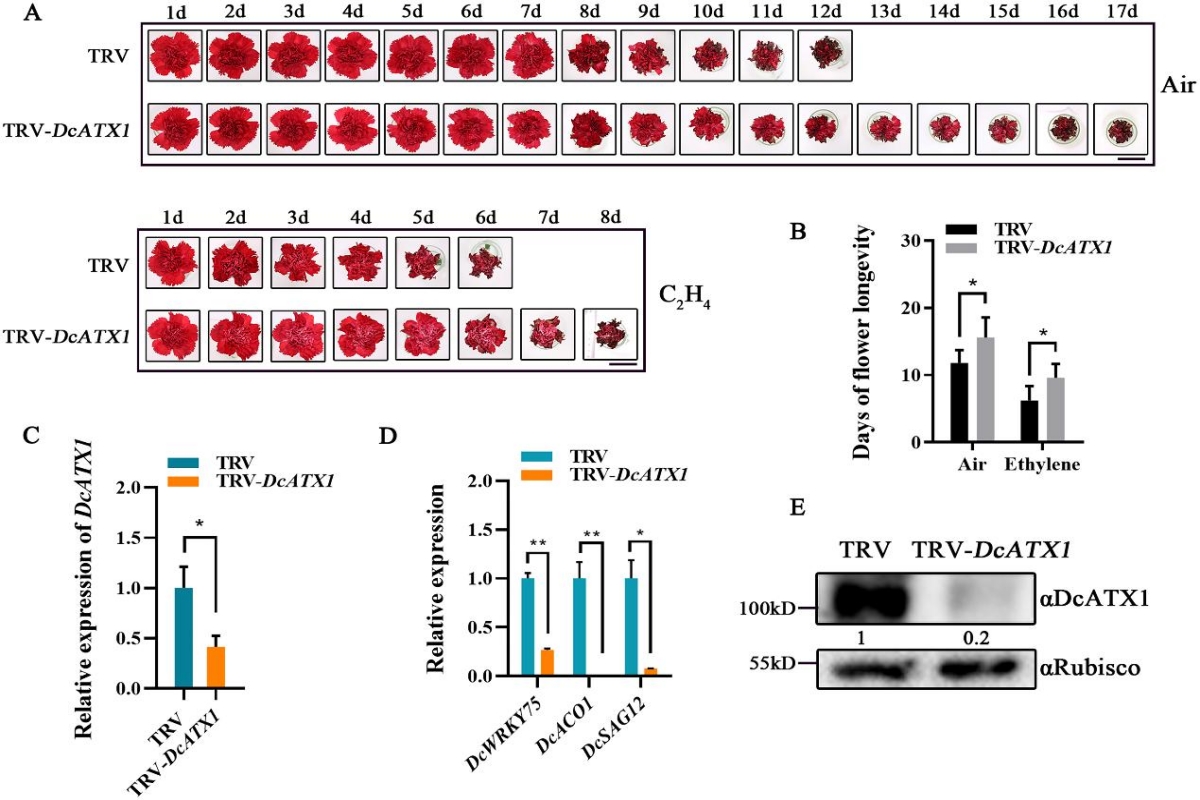
该论文发表在国际学术期刊Plant Physiology上
南湖新闻网讯(通讯员 冯珊)近日,我校果蔬园艺作物种质创新与利用全国重点实验室、湖北洪山实验室、国家柑橘保鲜技术研发专业中心、华中农业大学花卉研究所和农业农村部华中都市农业重点实验室张帆教授课题组通过组学和分子生物学实验揭示了组蛋白修饰调控乙烯诱导的康乃馨鲜切花采后衰老过程的分子机理,进一步拓展了人们对乙烯调控康乃馨鲜切花采后衰老分子机制的认识,为培育货架期和瓶插期延长的康乃馨新品种奠定了关键的理论基础。该研究以“Histone H3K4 methyltransferase DcATX1 promotes ethylene induced petal senescence in carnation”为题发表在国际学术期刊Plant Physiology上。
花卉是极其重要的园艺作物,在满足人们的精神需求,服务乡村振兴和美丽中国建设中发挥着越来越关键的作用。康乃馨又名香石竹(Dianthus caryophyllus L.),是世界四大鲜切花之一,具有极高的观赏价值和经济价值。康乃馨同时也是一种典型的乙烯敏感性切花,被认为是研究乙烯调控鲜切花采后衰老,特别是花瓣衰老的模式植物。张帆教授课题组前期研究系统解析了乙烯分别通过下游“油门”组分DcWRKY75 (Xu et al, Plant Journal, 2021, 108: 1473-1492)、DcWRKY33 (Wang et al. Plant Journal, 2023, doi.org/10.1111/tpj.16075)和“刹车”组分DcHB30 (Xu et al, Journal of Experimental Botany, 2022, 73: 7326-7343)、DcERF-1 (王妍等, 园艺学报, 2022, 49: 1313-1326)调控康乃馨花瓣衰老的分子机制,但对表观遗传是否调控以及如何调控康乃馨花瓣衰老仍知之甚少。
为了详细分析表观遗传调控康乃馨鲜切花采后花瓣衰老的分子机制,本研究首先检测了与转录激活密切相关的组蛋白H3K4me3修饰水平的变化。研究发现,组蛋白H3K4me3修饰水平在康乃馨自然衰老和乙烯诱导的衰老过程中显著提升(图1),这说明表观遗传特别是组蛋白H3K4me3修饰的确参与了康乃馨鲜切花采后花瓣衰老的过程。

图1. 组蛋白H3K4me3修饰水平在康乃馨花瓣衰老过程中显著增加
进一步的研究发现,组蛋白H3K4甲基转移酶DcATX1具有催化H3K4三甲基修饰的活性,并在康乃馨花瓣衰老过程中发生明显的积累。通过VIGS技术瞬时沉默DcATX1能够明显延缓康乃馨花瓣的衰老进程,同时衰老相关转录因子,乙烯生物合成关键基因以及衰老相关基因的表达量明显下降(图2)。

图2. 沉默DcATX1能够明显延缓乙烯诱导的康乃馨花瓣衰老进程
进一步的分子实验表明,乙烯能够促进DcATX1在这些靶基因的启动子区域发生显著的富集,进而提升这些靶基因启动子区域H3K4me3修饰的水平,从而促进靶基因的表达(图3)。

图3. DcATX1促进靶基因启动子区域H3K4me3修饰的水平
本研究阐明了组蛋白H3K4甲基转移酶DcATX1调控乙烯诱导的康乃馨花瓣衰老的分子机制(图4),揭示了表观遗传调控康乃馨花瓣衰老的分子机理,进一步拓展了人们对乙烯诱导的康乃馨花瓣衰老分子调控网络的认识。这为培育货架期和瓶插期延长的康乃馨新品种奠定了关键的理论基础,同时对其他观赏花卉和鲜切花的采后保鲜也具有重要的理论和实践意义。

图4. 组蛋白H3K4甲基转移酶DcATX1调控乙烯诱导的康乃馨花瓣衰老的工作模型
华中农业大学果蔬园艺作物种质创新与利用全国重点实验室博士后冯珊为论文第一作者,张帆教授为论文通讯作者,程运江教授、包满珠教授和美国德克萨斯大学奥斯汀分校Hong Qiao教授参与了本研究。中国科学院植物研究所林荣呈研究员对本研究提出了宝贵意见。本研究得到了中央高校基本科研业务费专项基金(2662019PY049)和华中农业大学高层次人才启动经费项目等的资助。
英文摘要:
Petal senescence is controlled by a complex regulatory network. Epigenetic regulation like histone modification influences chromatin state and gene expression. However, the involvement of histone methylation in regulating petal senescence remains poorly understood. Here, we found that the trimethylation of histone H3 at Lysine 4 (H3K4me3) is increased during ethylene-induced petal senescence in carnation (Dianthus caryophyllus L.). H3K4me3 levels were positively associated with the expression of transcription factor DcWRKY75, ethylene biosynthetic genes 1-aminocyclopropane-1-carboxylic acid (ACC) synthase (DcACS1) and ACC oxidase (DcACO1), and senescence associated genes (SAGs) DcSAG12 and DcSAG29. Further, we identified that carnation ARABIDOPSIS HOMOLOG OF TRITHORAX1 (DcATX1) encodes a histone lysine methyltransferase which can methylate H3K4. Knockdown of DcATX1 delayed ethylene induced petal senescence in carnation, which was associated with the downregulated expression of DcWRKY75, DcACO1 and DcSAG12, whereas overexpression of DcATX1 exhibited the opposite effects. DcATX1 promoted the transcription of DcWRKY75, DcACO1 and DcSAG12 by elevating the H3K4me3 levels within their promoters. Overall, our results demonstrate that DcATX1 is a H3K4 methyltransferase that promotes the expression of DcWRKY75, DcACO1, DcSAG12 and potentially other downstream target genes by regulating H3K4me3 levels, thereby accelerating ethylene induced petal senescence in carnation. This study further indicates that epigenetic regulation is important for plant senescence processes.
论文链接:https://doi.org/10.1093/plphys/kiad008
审核人:张帆